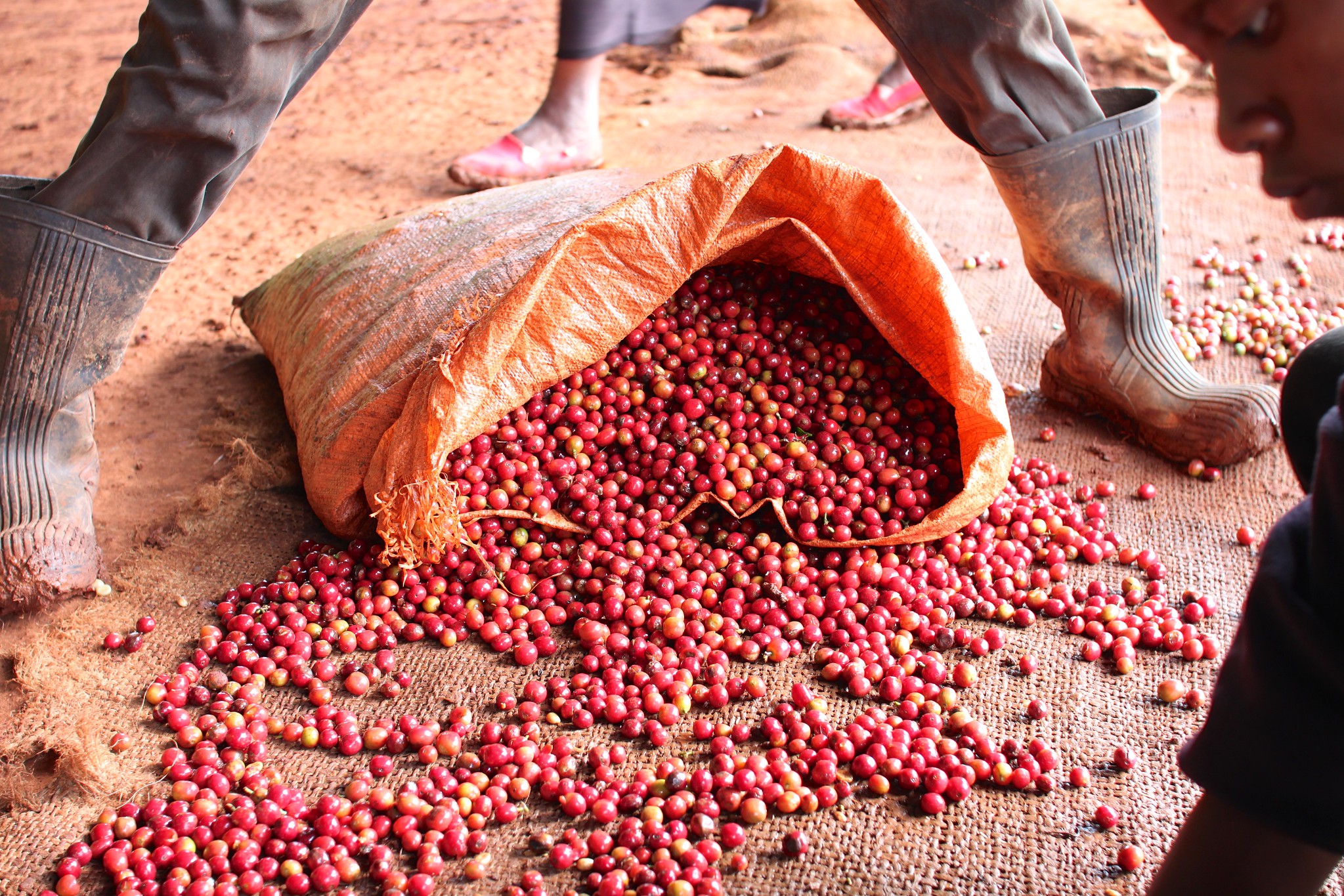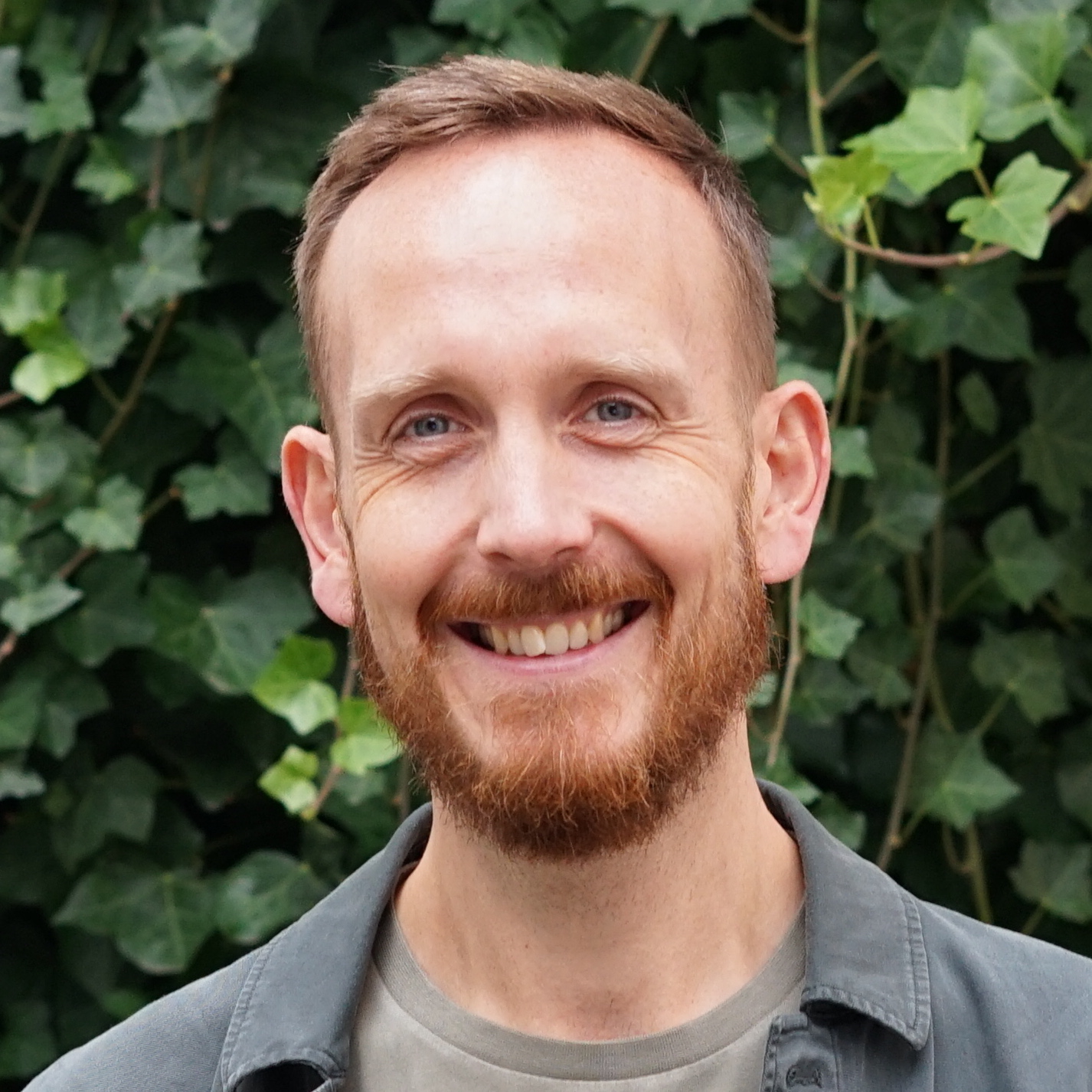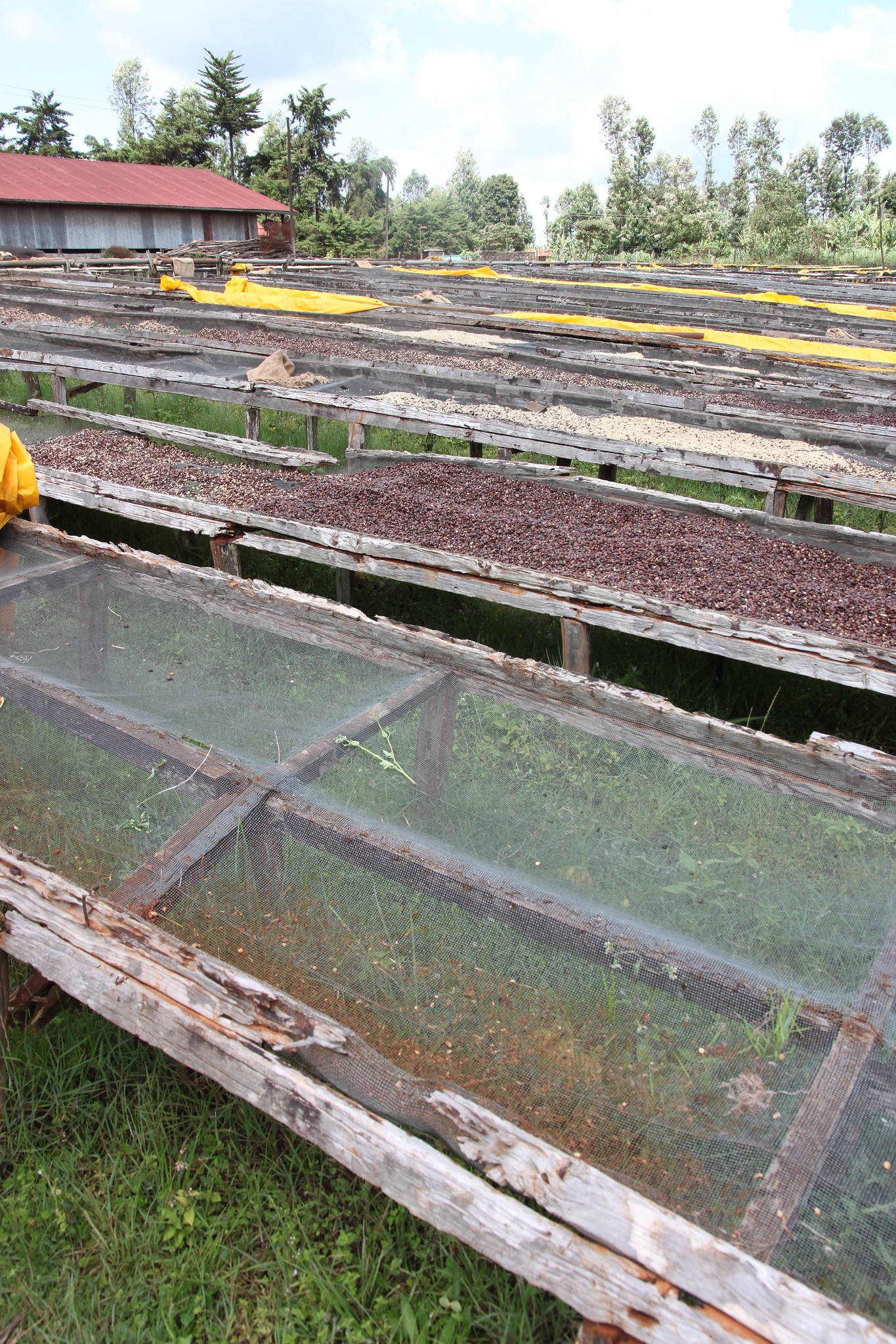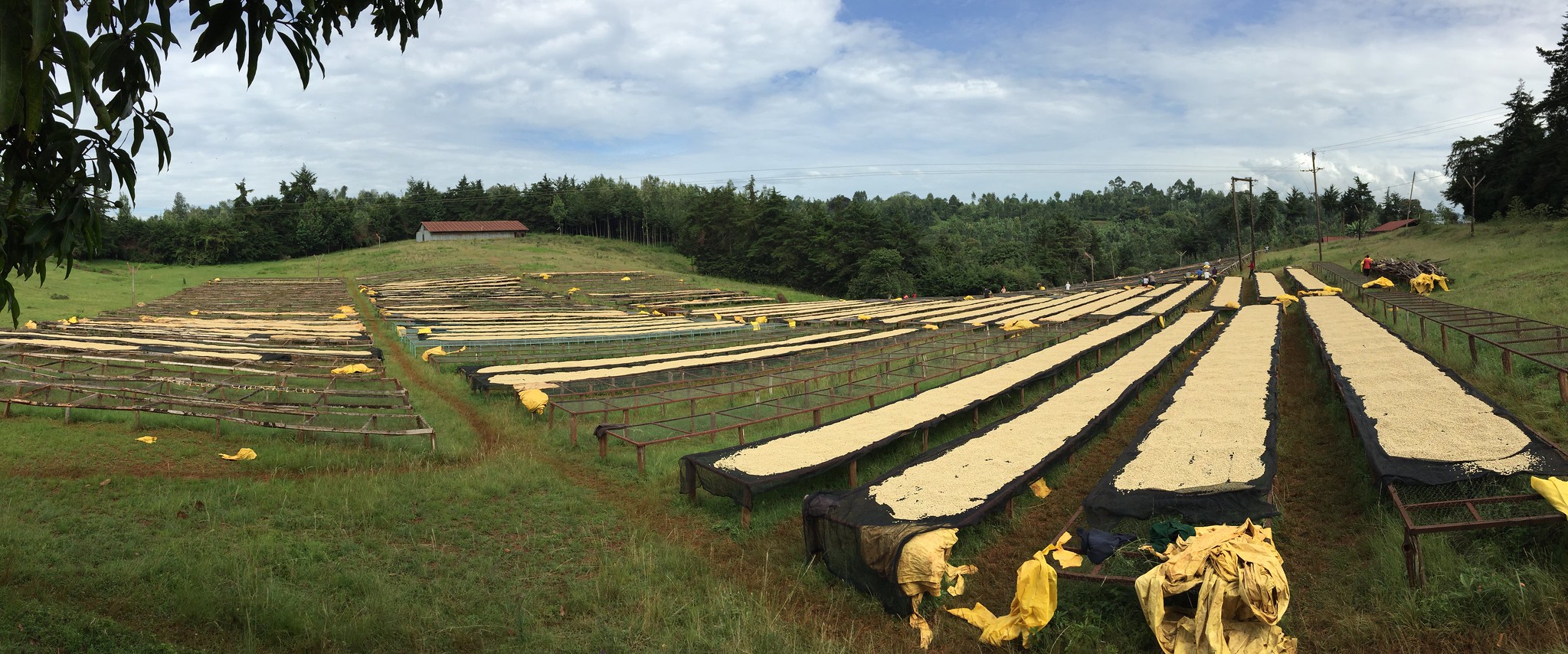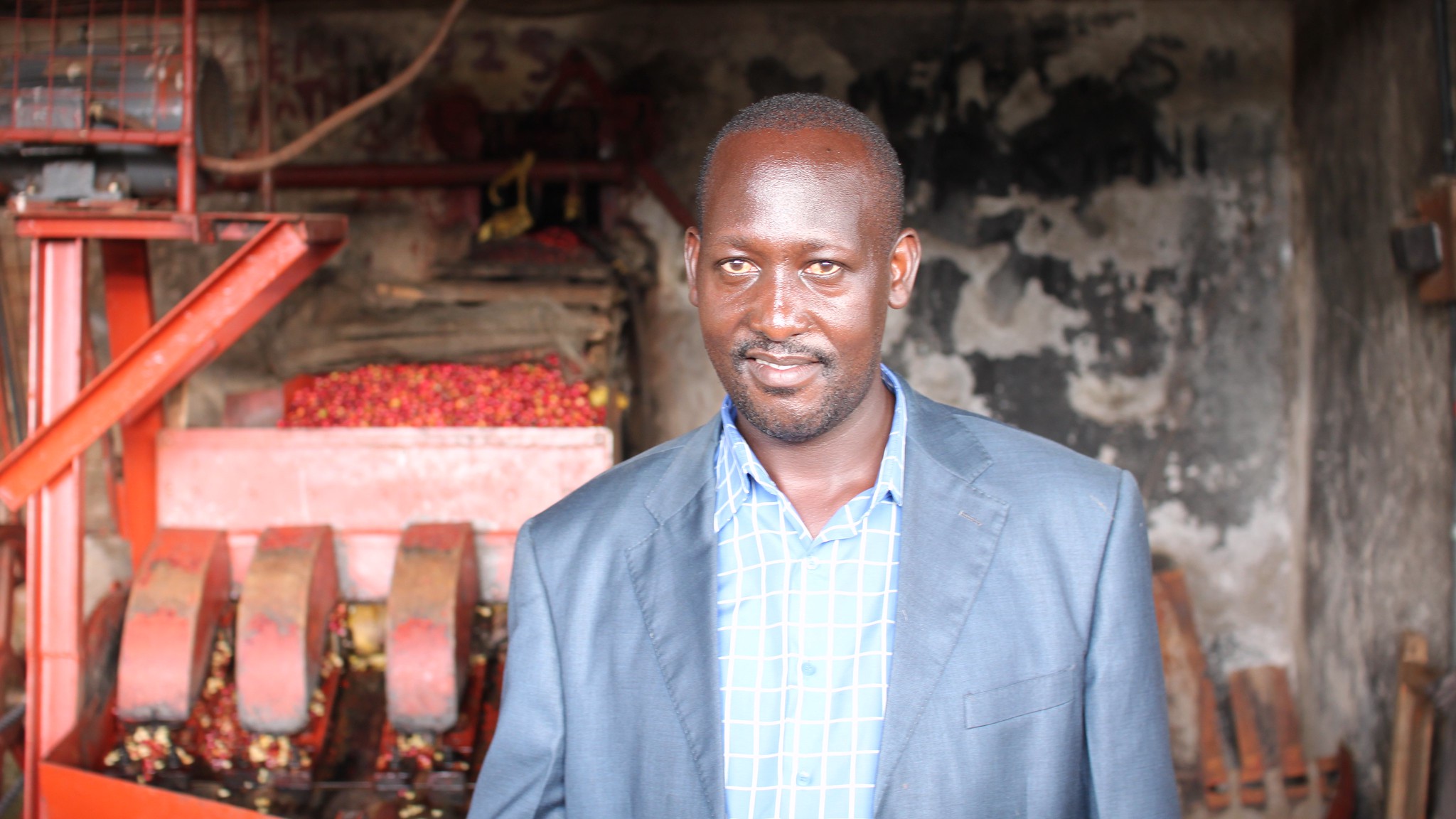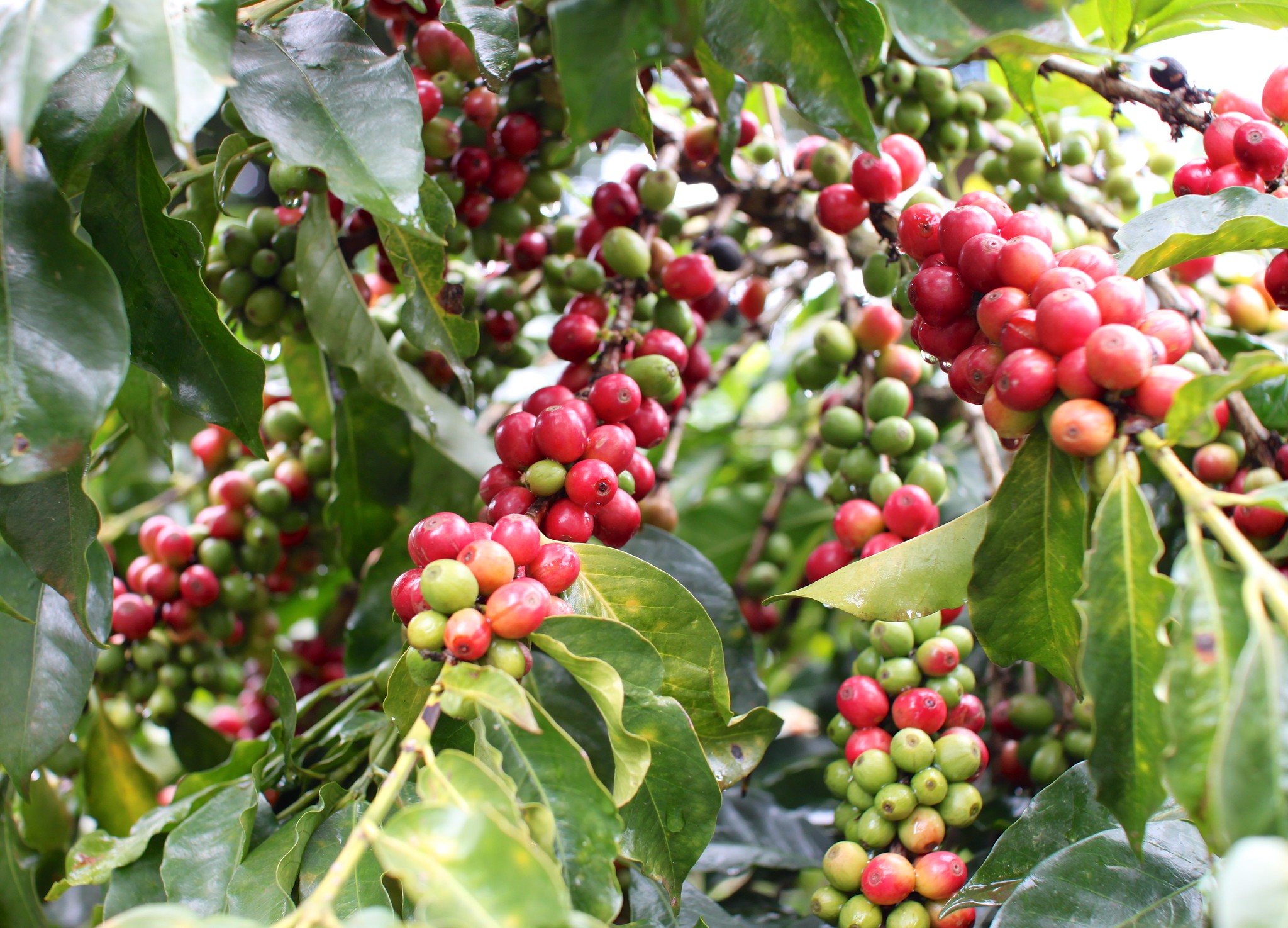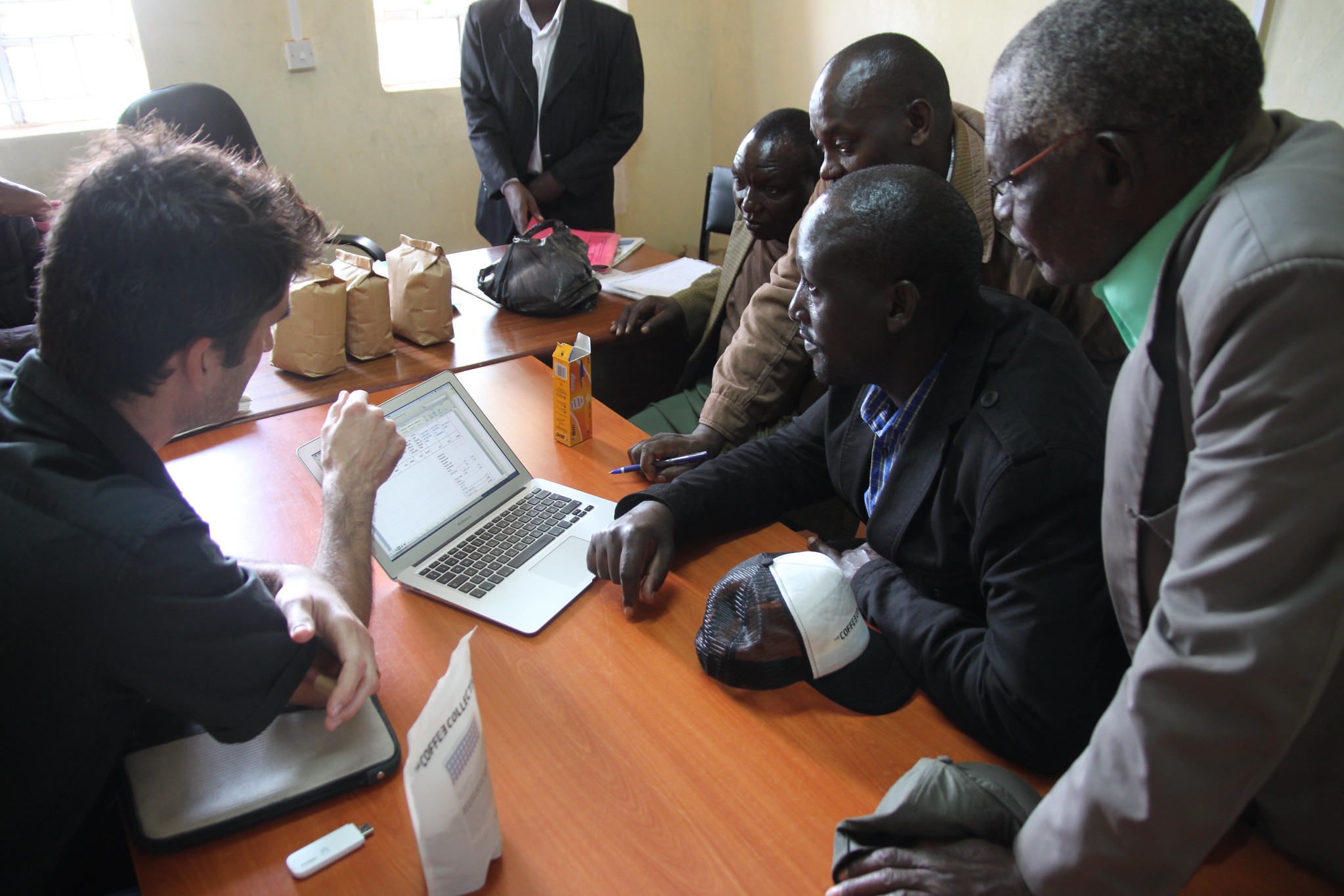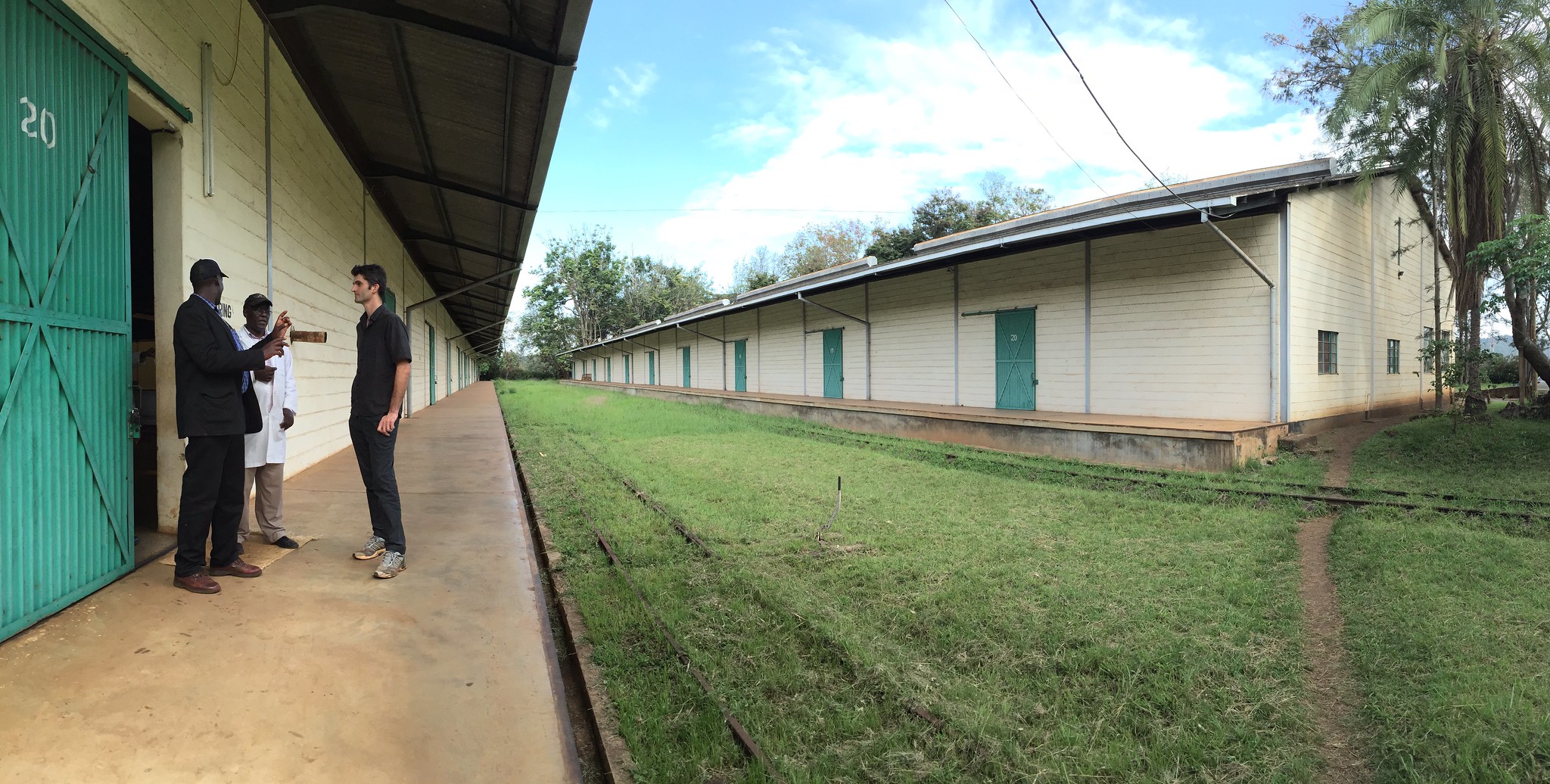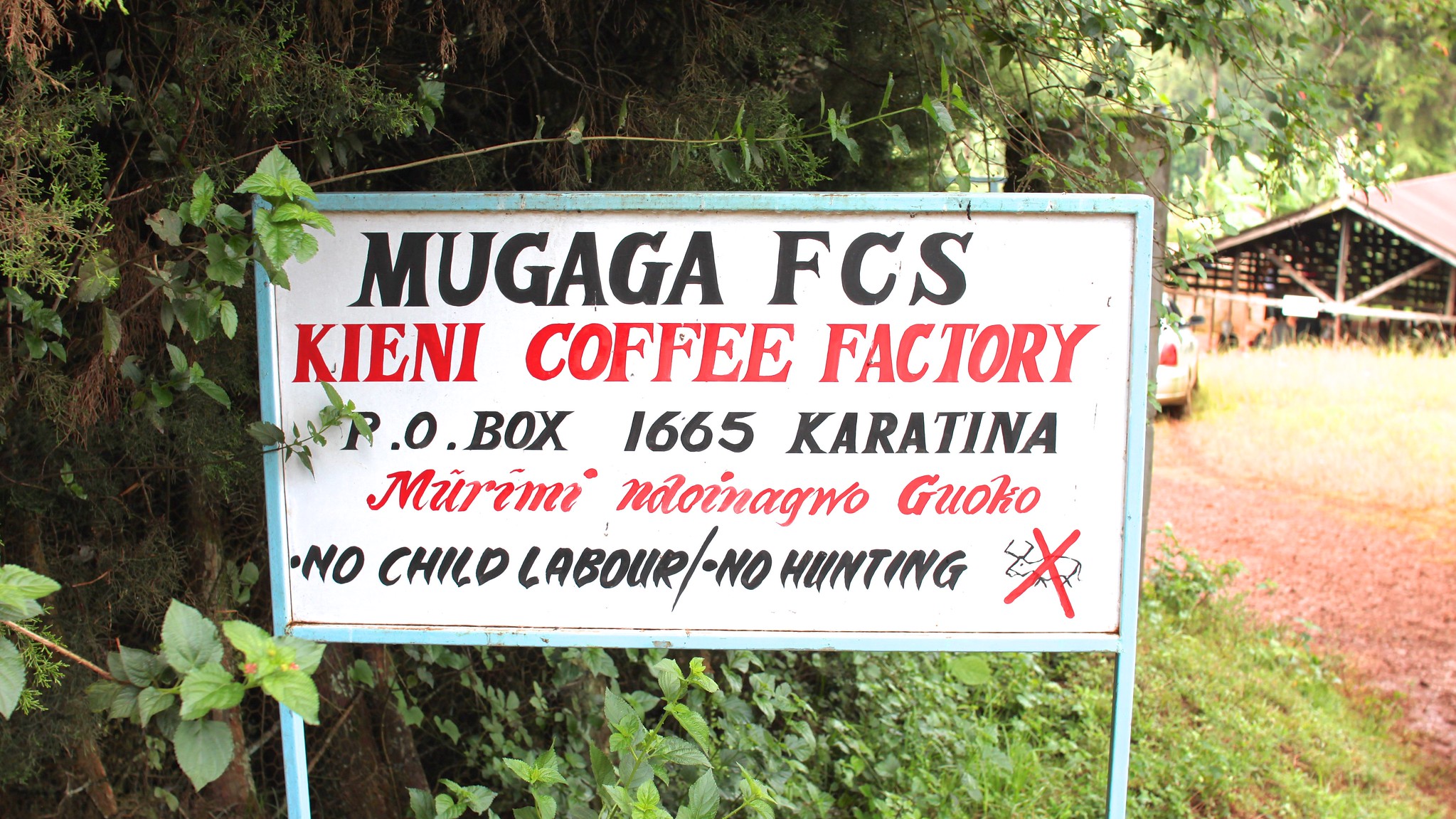Last year things were pretty chaotic in Kenya, to put it mildly. We managed to get coffee from Kieni directly, paying a good price to them and securing transparency and timely payment to the farmers.
In November Peter and I (Klaus) went to visit Kieni again to check out the harvest this year and talk about the coming crop. We thought initially that we’d be coming a little early for the harvest, but as it turned out they were at the peak of the harvest season when we arrived.
We made a little video to show what we saw, from picking the coffee, to delivering at the wet mill and onwards to the dry mill. For a description of what goes on during processing see this post.
Lots of exciting things are in progress at Kieni. Since last year they’ve invested in 14 new metal drying tables. As you can see on the picture below the old wooden ones tend to break, leaving the wire loose, so the coffee can’t be spread out evenly for an even drying. The metal tables also needs less maintenance.
Two years ago we gifted Kieni eight of these drying tables as a reward for producing a really high quality and because we felt we hadn’t paid them enough for that high quality. But it was a compromise, and the way we work, we don’t want to be giving things like that. We want to pay the highest price possible for the coffee and let the Kieni members decide how to spend it. If they want to pay it all out to the members, they should. If they can see an idea in spending some of the money on improving the wet mill, they should do that. But it needs to be their decision and not ours.
It’s something we feel quite strongly about and it seems to be going against the trend in the coffee sector. Lots of big corporations would rather set aside some money to build a school or the like for the community, which is also a handy way of showcasing your Corporate Social Responsibility program. We believe the community itself should decide over their money and that we should stay away from ear-marking how it should be spent.
Last year we didn’t buy as much coffee from Kieni, as we could have used, as we felt uncertain how the new marketing agent and exporter KCCE would handle the coffee. In the end everything went very smoothly and we had our coffee in very good time. Still, with the high price we paid, even though we only bought 2% of Kieni’s entire coffee harvest (all sizes and grades included) it accounted for 5% of their total earnings. This year we hope to improve even further on that. What was more important to us, was seeing the improvements made around Kieni. New water tanks for clean drinking water are installed at lot of the households of the Kieni farmers. Roads are looking better and new brick houses are being constructed.
KCCE, the Kenyan Cooperative Coffee Exporters, are a five year old company, owned by the farmers. They don’t make a profit for themselves and are run by a small staff in Nairobi. We met them in Sweden at the Nordic Roaster Forum a couple of years ago and Lucy and Phyllis who are in charge are very nice people. The KCCE run the KCCM (M for Mill) in Sagana, which they rent. Simon Gakinya, certified Q grader, manages the mill and cupping lab there together with Sarah, who is a great cupper. The mill is very well organized and when I went there last year I saw no reason why quality shouldn’t be good from that mill.
Charles Mwai Ihatu have been the chairman of Kieni since the first year we bought from them and was last year re-elected for another 3 years this august. He stresses the importance of our relationship with them and the fact that we’re loyal to them. The prices we’ve paid have made a difference to them and they feel more enthusiastic about producing coffee then ever. Last year it meant that Kieni (and the whole Mugaga society) made a profit where a lot of other societies didn’t.
Prices for coffee in Kenya, like most of the world, have fluctuated through the years making coffee a tough product to have as your main income for the farmers. When prices were at its’ best Kieni was able to pay out a bit more than 100 kenyan shillings (ksh) pr kg of cherry to the members. Two years ago (the 2012/13 harvest) that was only ksh 42. Last year it improved to ksh 70. Talking to the farmers it’s clear that anything below ksh 60 is incredibly dissatisfying. It’s where you’d basically close shop if you had better options. The dream is to get close to ksh 100 again but more importantly that the prices would stabilize. If roasters engage more directly with farmers or coops like Kieni, it’s a not far off. The direct sales ensure better prices to the farmers, and relationships between the coops and roasters are what every farmer I’ve met down here wish for.
The harvest this year is going to be a small one. Probably around half the amount of last year. In figures, the total amount at Kieni last year was 856.000 kilos of cherry harvest and they only expect 450.000 kg cherry this year. Quality seems to be better though, so hopefully it’ll mean higher prices to the farmers to make up for the loss in yield. As we were walking around the farms and at the receiving station at Kieni we saw some of the biggest coffee cherries we’ve ever seen. With less fruit on the tree, more nutrients can go to each cherry, provided the soil is rich and the farmers has been taking care of the trees. So far it looks like there will be a lot more AA and AB (the largest sizes) which is good for the farmers as they fetch higher prices. We’re also looking at buying ABs from Kieni since they taste better than AAs from a lot of other mills.
Kieni is now using more and more organic manure instead of chemical fertilizers. With help from agronomist Douglas Maina they are trying to improve to more organic practises. I’ve never seen a certified organic coffee in Kenya and doubt it’ll happen in the next many years, as they are combatting lots of deceases, like the CBD – Coffee Berry Decease. Still, it’s very nice to see a change in the approach to farming and how to take care of the land.
Peter (with his background in systems ecology) was very impressed by seeing this movement towards more organic practices. On top of using more manure they also worked with multi cropping, where they both grow bananas, avocado and other large trees around the coffee trees and vegetables on the ground as pumpkins or beans (that will even add nitrogen to the soil). This will give the farmer food security and thereby leaving them more self-sufficient and independent and it will make the ecosystem more complex and healthy. At best this move towards more organic practise will create more healthy ecosystems and as such create a better natural resistance against deceases and pests. And a hope could therefore be that in the longer run it will be possible to combat even CBD in an organic way when the benefits of a more healthy ecosystem will have developed enough to protect the coffee also.
Anyway, in the short run, since the Nyeri county have gotten more involved they have been able to buy fertilizer as a group at almost half the price of what they used to pay. Good news for the farmers as the stuff is expensive for them.
We also spent quite a lot of time with the Mugaga society board. Besides Kieni there’s four other wet mills in the society: Kagumoini, Gatina, Kiamabara and Gathugu. One of the concerns often heard about the society structure is that they are poorly managed and corrupt. Kieni have previously won the Dormans awards for being the best managed factory and Mugaga for the society. A few years ago Kieni was the mill that paid out the highest earning to it’s members, because of how well managed they are. We were also happy to see that all their books were open to us and they could account for everything.
Mugaga does the accounting for all the factories and the members have to approve the audit. Pretty much just like it would be in Denmark if it was a shareholder company. Then it’s also audited by the Minister of Agriculture in Nyeri County. Finally it’s audited in Nairobi by the government under the Minister of Industrialization and Development, who also checks that it follows the national laws (the Cooperative Societies Act).
The audited accounts are publicly available and we got a copy to carry home. Not that we really needed it after we’d gone over the numbers at Kieni. We don’t want to seem like we don’t trust the people at Mugaga, but since it’s a concern often raised by outsider, we felt it was good to dig deep into this and make sure everything checks out. We also believe that by having the direct contact and asking these questions, we do the best we can to keep the good accounting practices in place towards transparency and to mitigate the possibilities for corruption.
At the end of the harvest the Sagana mill do a report for transparency for the society and individual factories of how many kilos of each grade been produced. They also compare mill loss between lab and actual mill production allowing only a 3% discrepancy. After selling the coffee to roasters KCCE also send a report to the society regarding the sales, stating at which price each lot was sold for.
Last year there were some problems that farmers weren’t paid on time from KCCE. We knew that wasn’t an issue with Kieni, as we talked with them on the phone quite frequently and knew they had the money in their bank account within a few days of us making the transfer. The problem was due to the situation last year, where coffee was on hold at the wet mills for a long time. It meant that the coffee wasn’t delivered to the mills until very late, missing a lot of the sales to abroad. And as we all in the coffee business know it takes time to build a market. KCCE has been working hard on this during the last year, but the amount of coffee they are marketing exploded from one year to the next and therefore it took time to find costumers for all the coffee.
In this way the political point that has been made, that the Guvenor of Nyeri did this change too fast, can be said to have some justification on this subject. We know from ourselves how sceptical we were when we heard that the politics had changed the trade system in Nyeri and how careful (and thereby slow relative to our normal practices) we where in the process before we finally bought the Kieni coffee. So KCCE took a long time to market and sell the coffee internationally, resulting in late payments to the farmers. This year coffee is moving at the usual time and there’s no indications it’ll be a problem.
As I’m writing the final lines of this blog post I’m actually back in Kenya and it’s January. I’ll do my best to finish a post about this trip soon with more updates -at least it won’t be three months again.
Check out more pictures from the trip in this Flickr album:
https://www.flickr.com/photos/coffeecollective/sets/72157649590899231/
Would you like to get our different coffees delivered directly to your doorstep? We've got you covered.
Address
Coffee Collective
Godthåbsvej 34B
2000 Frederiksberg
CVR: 30706595
Contact
mail@coffeecollective.dk
+45 60 15 15 25 (09.00-15.00)
Coffee and cookies
This site uses cookies.
Find out more on how we use cookies.
